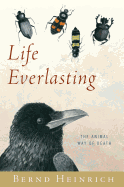
Death is usually considered the end of life, but in Life Everlasting, naturalist Bernd Heinrich (The Nesting Season) explains in fascinating detail that it's just a continuation of the life cycle, as the death of one animal provides life for other species--from Nicrophorus beetles that bury dead mice as a food source for their larva to the larger scavengers such as ravens, vultures and coyotes that "open" carcasses for smaller animals and insects.
Heinrich meticulously discusses how the death of a tree provides sustenance for insects and fungi and how dung beetles in Africa can live on the wasted nutrients they find in elephant dung. He dives into the ocean with an intriguing look at dead whales, whose carcasses can feed hundreds of other creatures as they take years to completely decompose. Life Everlasting also raises moral and philosophical concerns about the role humans have played in the death cycle considering that "one of the most damaging practices affecting the undertakers' [animal scavengers] livelihood may be our deliberate removal of carcasses that have, throughout evolutionary history, been left to return to the earth." It's an intriguing perspective on the practice of burying our dead in concrete tombs--a process which disrupts the natural return of the nutrients in the human corpse to the soil. Dense and compelling, Life Everlasting scrutinizes a subject that many might find taboo and questions whether modern burial practices are for the best. --Lee E. Cart

